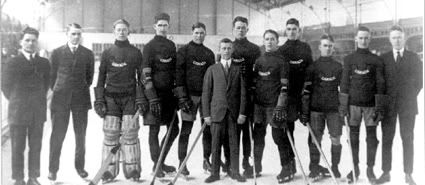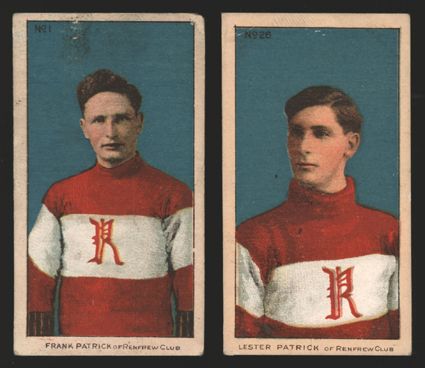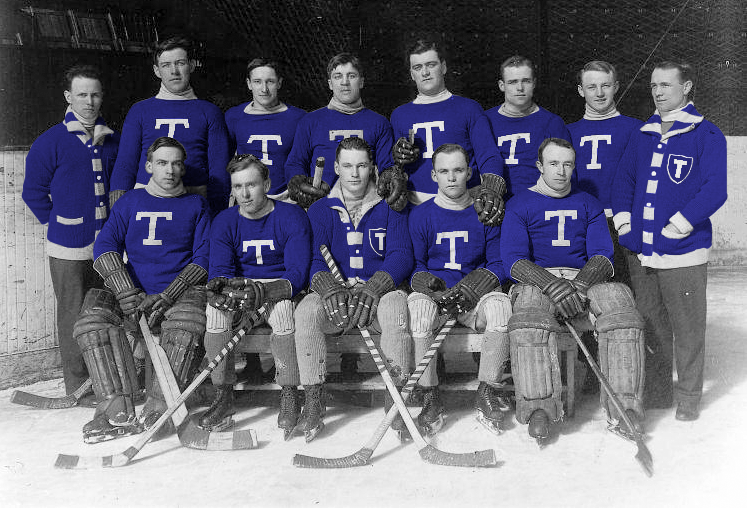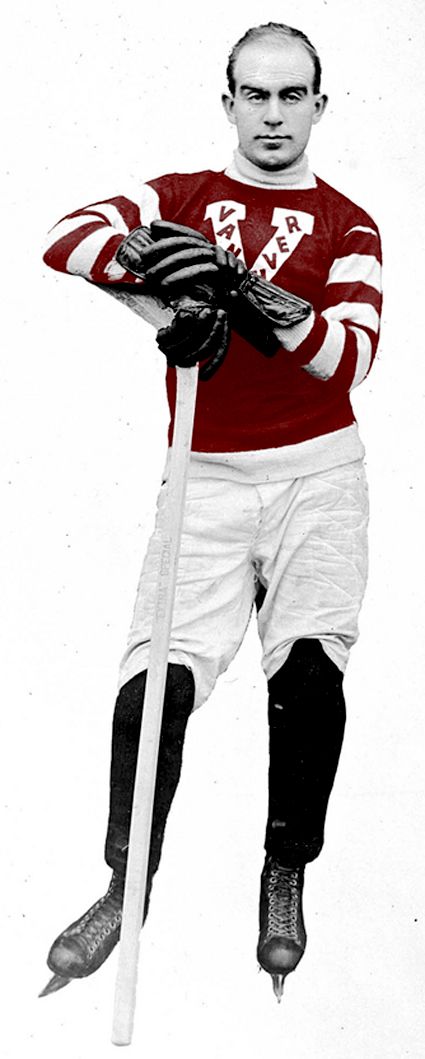As the game evolved and the players skills improved, the need for the extra player fell out of favor as a way to make more room on the ice and speed up the game.
Shortly after it was formed in 1910, the direct predecessor to the National Hockey League, the National Hockey Association (NHA), decided to drop the Rover position and reduce the number of players on the ice to today's familiar six - five skaters and a goaltender.
Meanwhile, out west, the Pacific Coast Hockey Association, led by Frank and Lester Patrick chose to keep the Rover as a part of their lineup. While the Patrick's were innovators, introducing many new concepts to the game, such as blue lines, goal creases, forward passing, player numbers, penalty shots, playoffs and allowing goalies to leave their feet, they did cling to the Rover position.
This resulted in a compromise, as the Stanley Cup was still a challenge cup at the time of the formation of the NHA. The first time the NHA champions were challenged by the representative of he PCHA was in March of 1914 in a best of five series when the Toronto Hockey Club defended their rights to the cup against Lester Patrick's Victoria Aristocrats. Game 1 of the series was played under NHA six man rules and was won by Toronto 5-2.
Game 2 was conducted under PCHA rules of seven man hockey, which also meant utilizing the blue lines to divide the ice into three zones. It was a much closer game that eventually went to overtime tied at 5-5 before Toronto prevailed when Rover Roy McGiffin scored after 18 minutes of overtime.
Again playing under NHA rules, Toronto prevailed in a much tighter contest in Game 3 by a final score of 2-1 to win not only the game, but the best of five series 3 games to none.
At this point in the development of the game, the two leagues were the top two professional leagues in Canada and the Stanley Cup evolved from a challenge cup to a format where the winner of the NHA faced off against the champion of the PCHA every year for the cup in a best of five series, which alternated each year between the eastern NHA and the western PCHA as the host. Additionally, every other game would alternate between six man NHA and seven man PCHA rules.
In 1915 the Vancouver Millionaires defeated the Ottawa Senators 3-0 to become the first PCHA champion, striking a blow for the continued use of the Rover. 1916 saw the cup return to the east when the Montreal Canadiens won the first of 24 cups in franchise history when they defeated the Portland Rosebuds 3-2. The cup returned to the west in 1917 when the Seattle Metropolitans became the first team from the United States to win the rights to the cup when the defeated the Canadiens 3-1.
In 1918 the Toronto Arenas of the newly formed National Hockey League, who would eventually evolve into today's Toronto Maple Leafs, took the cup back for the NHA with a 3-2 series win over the Millionaires.
The 1919 finals in Seattle were called off after Game 5 with each team having won twice with one tie due to an outbreak of influenza when most of the Canadiens players fell ill and were hospitalized, with "Bad" Joe Hall of Montreal dying four days later.
The first Olympic ice hockey tournament in 1920 saw teams play seven man hockey with the Rover position used for the only time in Olympic play.

The first Olympic hockey champions, the Winnipeg Falcons representing
Canada played seven man hockey with a Rover in 1920
The Senators regained the cup for the first time since 1911 when they outlasted the Metropolitans 3-2 in 1920, taking advantage of the familiar NHL six man rules to win "at home" in Game 5, which was played in Toronto due to unfavorable ice conditions in Ottawa.
Ottawa retained the cup in 1921 in a series played in Vancouver that went the full five games as the Senators took the decisive Game 5 played under seven man PCHA rules.
The 1922 series took place in Toronto between the Millionaires and the NHL's Toronto St. Pats, who were an evolution of the 1918 champion Toronto Arenas. Vancouver took Game 1 by a score of 4-3 under six man rules. Game 2 was a 2-1 overtime win for the St. Pats playing under the PCHA's Rover rule book. Again under the NHL's six man format, the PCHA's Millionaires shut out Toronto by a score of 3-0 to to take a 2-1 series lead and put Toronto on the brink of elimination.
On this date in 1922, the St. Pats dominated the Millionaires by a score of 6-0 as John Ross Roach became the first rookie to record a shutout in Stanley Cup play in the final game for the Rover position.
Three days later, Babe Dye would lead the St. Pats comeback from their 2-1 series deficit by scoring 4 of Toronto's 5 goals in their 5-1 win to take the series 3 games to 2 to close out the Rover era once and for all.
For the 1922-23 season, the PCHA would finally drop the Rover and adopt the six man hockey of the NHL 11 years after the NHA made the switch in order to free up space on the ice and increase the speed of play.
The Hockey Hall of Fame includes 19 players who played the Rover position and they are among some of the finest players to have ever played the game - and not just from the game's early days, as the Rover was charged with not only joining the offensive attack, but hurrying back up the ice to help out on defense, a heavy demand which required speed and endurance in the days before substitutions or the though of on the fly line changes.
Among those 19 Rovers in The Hall are hockey legends such as Hobey Baker, Tommy Dunderdale, Si Griffis, Newsy Lalonde, Frank McGee, Lester Patrick, Dider Pitre, Bruce Stuart, Harry Westwick and the great Cyclone Taylor.
Today's featured jersey is a 1914-15 Vancouver Millionaires Fred "Cyclone" Taylor jersey. From the time of their inception in1911, the Millionaires used maroon jerseys adorned with a large, white V of varying styles, most of which had the name "Vancouver" contained inside.
Taylor was one of the early greats of hockey, playing for the Portage Lakes team in the first professional league back in 1905-06. He subsequently played for the Ottawa Senators and the Renfrew Creamery Kings before being lured west by his former Renfrew teammates, the Patrick brothers, for their Pacific Coast Hockey League's Vancouver Millionaires in 1912, with whom he would play for the rest of his career, spending ten seasons with the club. His scoring exploits were the stuff of legend, as he scored 159 goals and 263 points in 130 games.
He was inducted into the Hockey Hall of Fame in 1947 as well as the Canadian Sports Hall of Fame, the British Columbia Sports Hall of Fame and the International Hockey Hall of Fame and was chosen to drop the puck for the ceremonial faceoff at the first ever Vancouver Canucks game in 1970.
Today's video section is a look at hockey's first superstar, Cyclone Taylor.


















No comments:
Post a Comment
We welcome and encourage genuine comments and corrections from our readers. Please no spam. It will not be approved and never seen.